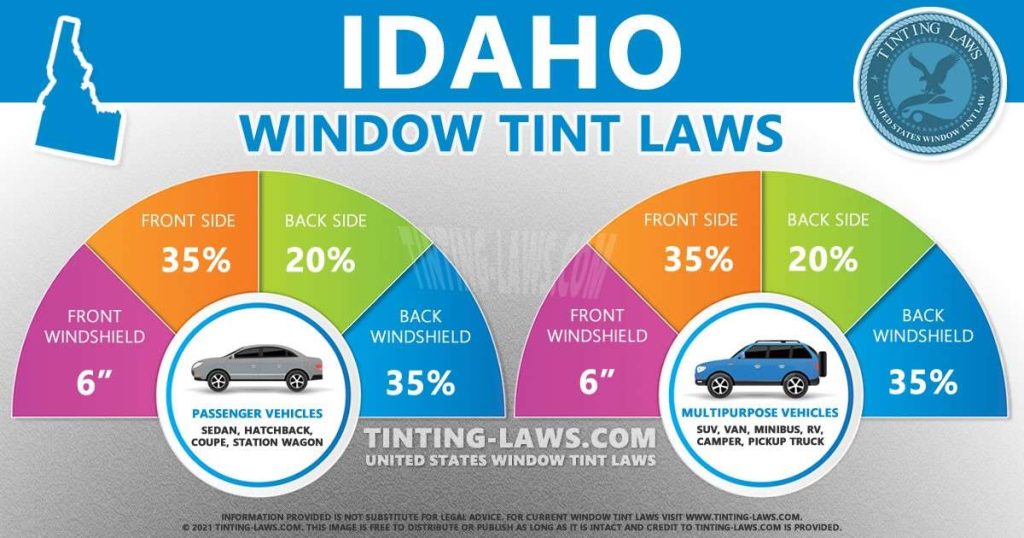Idaho Window Tinting Laws
Car window tinting laws in Idaho were enacted in 1992.
We have provided all the necessary information about your car’s window tint, including how dark or reflective the tint is allowed in your state.
There are also additional car window tinting rules and regulations in Idaho so make sure you read all about it below.
Window tint darkness in Idaho
The percent of visible light allowed through your car windows is called VLT: Visible Light Transmission.
The percentage of light allowed through your film and glass in Idaho is very specific and different for sedan cars and SUV cars or vans.
Tint darkness for sedans:
- Windshield: Non-reflective tint is allowed above the manufacturer’s AS-1 line or top 6 inches.
- Front Side windows: Must allow more than 35% of light in.
- Back Side windows: Must allow more than 20% of light in.
- Rear Window: Must allow more than 35% of light in.
Tint darkness for SUV and vans:
- Windshield: Non-reflective tint is allowed above the manufacturer’s AS-1 line or top 6 inches.
- Front Side windows: Must allow more than 35% of light in.
- Back Side windows: Must allow more than 20% of light in.
- Rear Window: Must allow more than 35% of light in.
Window tint reflection in Idaho
Window tint can reflect incoming light and reduce glare and heat.
Idaho window tint law permits a certain window reflection when using a tint so make sure you pay attention to this as well.
Tint reflection for sedans:
- Front Side windows: Must not be more than 35% reflective.
- Back Side windows: Must not be more than 35% reflective.
Tint reflection for SUV and vans:
- Front Side windows: Must not be more than 35% reflective.
- Back Side windows: Must not be more than 35% reflective.
Other Idaho window tint rules and regulations:
Idaho does have several other important laws, rules and regulations pertaining to window tinting. They include the following:
- Side Mirrors: Dual side mirrors are required if back window is tinted.
- Restricted Colors: No colors of tint are specified as banned.
- Tint Variance: State laws allow 3% light transmission tolerance.
- Certificates: Film manufacturers are not required to certify the film they sell in this state.
- Stickers: No sticker to identify legal tinting is required.
- Medical Exceptions: Idaho allows medical exemptions for special tint (75% on windshield and 20% on other windows).
- Penalties: Traffic infraction.
Keep in mind that Idaho tinting laws and regulations may be interpreted differently in your county or place of residence.
We always recommend double-checking our information with your local DMV or law enforcement authorities.

Our information about window tint laws in Idaho was last updated in 2024.
Tinting laws in Idaho were enacted in 1992.
In case any of our info provided is not up to date or correct be sure to contact us so we can fix it. Thanks!
Trusted industry leader in providing accurate window tint laws. Share with confidence:
State of Idaho Info
Idaho is a state in the north-western region of the United States.
Idaho is the 14th largest, the 39th most populous, and the 7th least densely populated of the 50 United States.
The state’s largest city and capital is Boise. Idaho is a mountainous state with an area larger than that of all of New England.

It is landlocked, surrounded by the states of Washington, Oregon, Nevada, Utah, Wyoming, Montana and the Canadian province of British Columbia.
However, the network of dams and locks on the Columbia River and Snake River make the city of Lewiston the farthest inland seaport on the Pacific coast of the contiguous United States.
Capital: Boise
Population: 1,595,728 (2012)
Area: 83,570 sq mi (216,632 km2)
Cities in Idaho: Boise, Idaho Falls, Nampa, Pocatello, Meridian, Caldwell, Coeur d’Alene, Lewiston, Twin Falls, Lewiston, Post Falls, Rexburg, Moscow, Eagle, Kuna, Mountain Home, Chubbuck, Ammon, Hayden, Blackfoot, Garden City, Jerome, Burley, Hailey, Payette, Sandpoint, Rathdrum, Emmett, Star, Rupert, Middleton, Weiser, Preston, Fruitland, American Falls, Shelley, Buhl, Rigby, Gooding, St. Anthony, Kimberly, Orofino, Grangeville, Salmon, Heyburn, Soda Springs, McCall, Wendell, Ketchum, Homedale, Montpelier
Counties in Idaho: Ada, Adams, Bannock, Bear Lake, Benewah, Bingham, Blaine, Boise, Bonner, Bonneville, Boundary, Butte, Camas, Canyon, Caribou, Cassia, Clark, Clearwater, Custer, Elmore, Franklin, Fremont, Gem, Gooding, Idaho, Jefferson, Jerome, Kootenai, Latah, Lemhi, Lewis, Lincoln, Madison, Minidoka, Nez Perce, Oneida, Owyhee, Payette, Power, Shoshone, Teton, Twin Falls, Valley, Washington